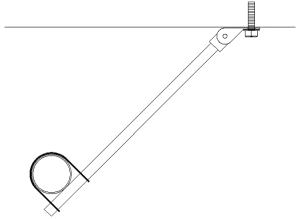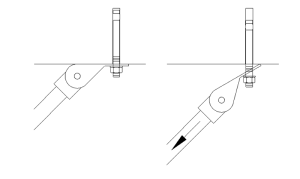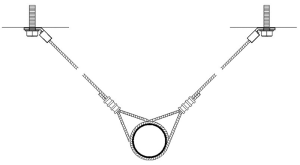Federal Laws, Executive Orders, Building Codes, Standards
This article discusses Federal Laws, Executive Orders, Building Codes and Standards that apply to the seismic design of nonstructural building components. It highlights various aspects of the seismic design requirements. The discussion is not all-inclusive; however, it does include requirements that are either new or commonly overlooked. References to specific nonstructural building components and seismic sway brace components are provided as examples.
Executive Order 13717
On February 2, 2016, President Obama signed an Executive Order (EO 13717) titled Establishing a Federal Earthquake Risk Management Standard. It sets out to establish requirements for earthquake safety of new federal buildings, improvements to existing federal buildings, and federally leased, financed, or regulated buildings. EO 13717 also indicates that federally financed buildings include those that are financed through federal grants, loans, or guaranteed financing through loan or mortgage insurance programs.
EO 13717 goes on to order that every new building covered by the order, and for which project assumptions, scope, budgets and strategy for building start after May 2, 2016, shall comply with the seismic provisions of the 2015 or later edition of the International Building Code (IBC).
According to EO 13717, the National Institute of Standards and Technology (NIST) currently leads the Interagency Committee on Seismic Safety in Construction (ICSSC) for The National Earthquake Hazards Reduction Program (NEHRP) and shall assist the federal agencies with implementing these earthquake risk-reduction measures. Each federal agency shall also designate a Seismic Safety Coordinator to serve as the focal point for compliance with the EO and to participate in the ICSSC.
Among other things not mentioned above, EO 13717 also revokes EO 12699, which was required by Public Law 101-614 to be signed by President Bush in 1990 and made the Federal Emergency Management Agency (FEMA) the lead agency in implementing NEHRP.
Public Law 101-614 was a 1990 amendment to The Earthquake Hazards Reduction Act of 1977 (Public Law 95-124), the effects of which are still dealt with today. While there have been additional amendments to Public Law 95-124 over the past one-quarter of a century, most of those have dealt primarily with funding issues. Public Law 101-614 required implementation of NEHRP, including the requirements of NEHRP Standards, and required the signing of EO 12699 to accomplish its implementation.
Federal Law, NEHRP, IBC and ASCE 7
Public Law 101-614 and EO 12699 apply NEHRP to new building construction started after January 4, 1993, and existing federal buildings, federally leased or regulated buildings, and buildings financed through federal grants or loans or guaranteed through Federal loan or mortgage insurance programs. Application of the new EO 13717 is virtually the same in this regard. Since the NEHRP standards are seismic provisions and not complete building codes, the most practical way to implement them was through the model building codes. The model building codes were the ICBO Uniform Building Code (UBC), National Building Code (BOCA) and Standard Building Code (SBCCI). Since FEMA would be judging eligibility for disaster-relief funding, the model code organizations wanted to make adjustments to their seismic requirements to demonstrate their compliance with NEHRP. Each of the model codes was allowed to self-certify their NEHRP compliance.
In the years following the passage of Public Law 101-614 and the signing of EO 12699, successive revisions were made to the NEHRP Standards, the three model codes, and their referenced standards. By 1996, they agreed not to publish updates to their codes and consolidate into one International Code Conference (ICC) and promulgate the use of one International Building Code (IBC) starting in 2000.
The 2000 IBC included the seismic maps and requirements of the then-current NEHRP standard, as did subsequent editions of ASCE 7 Minimum Design Loads for Buildings and Other Structures. Because of the required application of NEHRP to federal buildings, federal agency specifications, such as the Corps of Engineers Guide Specifications (CEGS) and now the Unified Facilities Guide Specifications and others, have references to NEHRP standards and ASCE 7. Today ASCE 7 is referenced by the IBC and virtually all the federal documents dealing with building construction requirements.
In 1990, it was not known that there would someday be an International Building Code, with ASCE 7 as its referenced standard, containing the seismic requirements that satisfy the federal laws and executive order implementing NEHRP, but that is the condition today. So, the requirements of the current EO 13717 do not differ greatly from the 1990 EO 12699. However, the new EO does make it clear that the 2015 IBC or more recent IBC edition is to be used to comply with the federal laws implementing NEHRP, and that NIST is the lead agency for NEHRP rather than FEMA.
ASCE 7 Seismic Design Requirements for Nonstructural Building Components
A significant portion of the work that is required to be done by NEHRP and the IBC is the earthquake protection of nonstructural building components, and these requirements are in the structural design requirements of the building code. Section 1613.1 of the 2015 IBC requires nonstructural building components to be designed and constructed to resist the effects of earthquake motions in accordance with ASCE 7. These nonstructural building components are architectural, mechanical, electrical, and plumbing equipment and systems, and Chapter 13 of ASCE 7 contains the seismic design requirements for them.
The Seismic Design Category (SDC) for the nonstructural building components is the same as that of the building that they occupy or to which they are attached. However, the Component Importance Factor (Ip) is not the same as the Building Importance Factor. The Importance Factor can be 1.0, 1.25, or 1.5 for the building but it is either 1.0 or 1.5 for the nonstructural building components. ASCE 7-10 requires that Ip shall be taken as 1.5, if the component is for life safety, including fire sprinkler systems; or, if the Authority Having Jurisdiction (AHJ) finds that component contains sufficient quantities of toxic or poisonous materials to pose a threat to the public if released; or, if the component is required for continued operation of a Risk Category IV structure; or, if the component contains enough hazardous material for the AHJ to classify the structure as hazardous. The Ip shall be taken as 1.0 for all other nonstructural building components.
There are general exceptions from the seismic design requirements of Chapter 13 of ASCE 7-10. These exceptions include:
- most storage cabinets six feet or less in height
- temporary or movable equipment
- architectural components with an Ip of 1.0 in SDC A or B other than parapets and shear walls
- MEP equipment in SDC A or B regardless of Ip
- MEP equipment in SDC C when Ip = 1.0
- MEP equipment in SDC D, E, and F when Ip = 1.0
- and it is positively attached to the structure
- and flexible connections are provided between the component and associated ductwork, piping and conduit
- and either
- the component weighs less than four hundred pounds with its center of gravity four feet above the floor, or
- the component weighs twenty pounds or less, or
- the component is a distribution system that weighs five pounds or less per foot.
Chapter 13 of ASCE 7 also contains additional exceptions from its seismic design requirements based on the size of the nonstructural building component or the method of attachment, such as hanger length.
Designated Seismic Systems
Some Designated Seismic Systems require special certification. Designated Seismic Systems are those nonstructural building components with Ip = 1.5 and require seismic design in accordance with Chapter 13 in SDC C through F. Special certification by the manufacturer is required for active mechanical and electrical equipment that must remain operational after the design earthquake. According to ASCE 7 C13.2.2, “active” designated seismic equipment is a limited subset of Designated Seismic Systems that has parts that rotate, move mechanically or are energized during operation, and as a rule of thumb can be limited to equipment with electric motors greater than 10 horsepower or greater than 200 MBH (one MBH equals 1000 BTU/hr). Pipes, ducts, conduits, and similar apparatus are not active equipment. Special certification by the manufacturer to maintain containment following the design earthquake is required for components with hazardous substances and Ip = 1.5 per Section 13.1.3. Special certification shall be certified based on either shake table testing, such as ICC-ES AC156, or based on experience data unless it can be shown that the component is inherently rugged. ASCE 7 C13.2.2 also states “Past earthquake experience has shown that most active equipment is inherently rugged.”
Concrete Anchor Capacities Prying and Overstrength
Among the other seismic design requirements in Chapter 13 are a consideration of allowable stresses on piping, based on ductile or non-ductile materials and the connection methods used, and more conservative design requirements for anchorage to concrete. Post-installed anchors in concrete have been required to be seismically prequalified in accordance with ACI 355.2 since the publication of ASCE 7-05. Post installed anchors in concrete have been required by ASCE 7 for many years to be designed in accordance with ACI 318 Appendix D and to consider the effects of prying and eccentricities, although the effects of prying have been overlooked in the design of seismic sway braces for nonstructural building components.
Prying (Figure 1), due to the geometry of the seismic sway brace brackets or fittings that are used for anchorage, can significantly increase the applied tension load on the anchor. This condition could influence the selection of sway brace brackets with more beneficial geometry. In addition, ASCE 7-10 Supplement No. 1 adds a column for Overstrength Factors (Ω0) to Tables 13.5.1 and Table 13.6.1, which assign Component Amplification Factors (ap) and Component Response Factors (Rp) to the range of nonstructural building components for which the seismic design requirements of Chapter 13 apply, with an Ω0 value of 2.5 for most of them. ASCE 7-05 required anchors in concrete be proportioned to carry at least 1.3 times the earthquake load. ASCE 7-10 Supplement No. 1 virtually doubles it with this change to using Ω0.
The NFPA 13 Standard for the Installation of Sprinkler Systems has been revised over the last four change cycles to include the applicable seismic design requirements of ASCE 7 through each of its change cycles. This change includes tables that address allowable stresses on piping, the requirement to use ACI 355.2 seismically prequalified concrete anchors, along with the effects of prying, and tables for reduced allowable earthquake loads based on Ω0. Accordingly, NFPA 13 has maintained its status as an ASCE 7 complying standard.
Seismic Sway Bracing
The nonstructural building components that are required to be designed in accordance with the seismic design requirements of ASCE 7 Chapter 13 are architectural, mechanical, electrical and plumbing equipment that are floor, roof, and wall mounted, or suspended from the building structure.
Generally, the earthquake protection of suspended nonstructural building components is provided by installing seismic sway bracing that is required to be designed in accordance with ASCE 7 Chapter 13 and includes consideration of both horizontal and vertical earthquake effects. While the vertical earthquake effects are both upward and downward, the downward vertical effect is often overlooked. ASCE 7-10 Section 12.4.2 requires that the seismic load effect includes the vertical effect, both upward and downward, and applied simultaneously with the horizontal load effect.

Figure 2. Tension/compression sway brace. (Strut, pipe or angle iron type, hanger not shown for clarity.)
There are two types of seismic sway brace. One type resists back and forth shaking motion of the horizontal earthquake load in tension in one direction and compression in the other. Figure 2 shows an example of such a sway brace installed in the transverse direction on suspended piping but the same principals apply for other suspended nonstructural building components. These sway braces commonly use strut, pipe or angle iron for the primary sway brace element.
The second type resists back and forth shaking motion of the horizontal earthquake load in tension only. This second type uses steel cable for the primary sway brace element. Figure 3 shows an example of a tension-only (cable type) sway brace installed in the transverse direction on suspended piping, but the same principles that apply to cable-type sway braces also apply for other suspended nonstructural building components.
An upward vertical reaction results when either type of sway brace resists the horizontal earthquake load in tension because both types are free to rotate about their connection to the structure. However, a downward vertical reaction results from seismic sway braces that resist the horizontal earthquake load in compression and adds a substantial load to the vertical support for the nonstructural component. Tension only (cable type) seismic sway braces cannot resist the horizontal earthquake load in compression; therefore, they cannot have a downward vertical resultant load on the nonstructural component hanger.
Code-Referenced Sway Brace Standards
There is no IBC or ASCE 7 referenced standard for the strut, pipe or angle iron type seismic sway brace components. However, there is an IBC and ASCE 7 referenced standard for the steel cable type seismic sway brace components, and it is ASCE 19 Structural Applications of Steel Cable for Buildings.
Section 102.4 of the 2015 IBC states that the standards referenced in it are considered part of its requirements, but that the requirements of the IBC take precedence if there are any conflicts between them. Section 2208 of the 2015 IBC requires that steel cables for buildings be in accordance with ASCE 19, and only ASCE 19.
Section 1613.1 of the 2015 IBC requires nonstructural building components to be designed and constructed to resist the effects of earthquake motions in accordance with ASCE 7. Chapter 13 of ASCE 7-10 defines the seismic design requirements for nonstructural components, and Section 14.1.6 requires steel cables to be in accordance with ASCE 19.
ASCE 19-10 Section 4.1 Cable Specifications includes ASTM A1023 Standard Specification for Carbon Steel Wire Ropes for General Purposes, Table 9, which is galvanized steel aircraft cable, and refers to Commentary Section C4.0 for the specific application. Commentary Section C4.0 states that ASTM A1023, Table 9, is listed to allow small-diameter galvanized steel cables to be used for seismic sway bracing of nonstructural building components.
ASCE 19-10 Section 3.3.1 requires a reduction in the available cable strength caused by cable end fittings based on the fitting reduction factors in Table 3-1, which no longer includes U-shaped cable clips or wedge type fittings. Also, Section 3.3.2 requires end fittings to develop an ultimate strength greater than the nominal cable strength. There are cable fittings on the market which make it possible to secure a cable loop by sliding the cable through one side and then back through the other side with a wedge, usually with serrated teeth that bite into the outer wires of the cable when tension is applied. U-shaped cable clips and wedge type fittings are prohibited by ASCE 19 because they “damage the cable and/or loosen over time.” Such cable fittings do not develop an ultimate strength greater than the nominal cable strength, and ASCE has issued a formal interpretation regarding their prohibition along with the reasons for it. This formal interpretation to ASCE 19-10 was published online in the ASCE Library.
Conclusion
In conclusion, while the Executive Orders of 1990 and 2016 are not dramatically different, the requirements for seismic sway bracing of nonstructural building components have changed significantly. Since the new EO requires compliance with the 2015 (or later) IBC, the referenced standards mentioned above have become critically important in the design and construction of federally owned, leased, regulated or financed buildings – and, of course, all buildings where International Building Code compliance is required.▪


